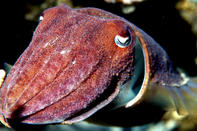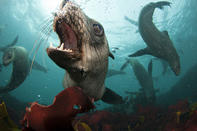Justin's Caves

Average depth: 12 m
Maximum depth: 18 m
This is a very exciting dive with large underwater caverns, overhangs and beautiful swim-throughs for both advanced and open water divers. This is a great night dive but the entry and exit points are very tricky – also note that the surge can be very strong through the caves when a swell is running. Justin’s Caves is usually dived in summer when the water is clear, but cold. You might want to take a torch with to bring out the colours of the corals and anemones on the ceilings and walls of the caverns. Many Hottentots and other small fish are present, along with some small harmless bottom-dwelling sharks. Crayfish are quite abundant and Cuttlefish have also been seen here so keep your eyes open. Shoals of small fish can usually be seen swimming through the dense kelp forest.
The Schuilenberg
Average depth: 7 m
Maximum depth: 10 m
The Schuilenberg was wrecked in 1756 while carrying provisions from Table Bay to False Bay. The only remains of the wreck are three cannons that are partly partially buried in sand. This is not a particularly colourful or scenic dive but you may enjoy the historic aspect of the site. The cannons are shallow enough to be snorkelled, and this may be a better option since it is quite a mission to get to the site with all your scuba gear. Marine life isn’t particularly colourful and is mostly dominated by kelp, Hottentot, Roman and crayfish. The sea has to be calm with no surge if you want to dive this site, as the wreck lies in the surf.
SS Seafarer
Average depth: 5 m
Maximum depth: 8 m
The Seafarer was an 8 000 ton Safmarine freighter that was wrecked during a storm in 1966. The ship broke up quickly and most of the cargo was lost and came to rest on the seabed. Although the propeller shaft is still visible, most of the fittings were removed shortly after the wrecking. Seals can be found on this dive along with fish and Nudibranchs. Shortspine urchins, as well as colourful anemones and Chitons, can also be seen on this wreck.
The RMS Athens

Average depth: 5 m
Maximum depth: 7 m
The RMS Athens was a mail steamer which was wrecked in 1865 during a great gale storm with the loss of the whole crew of 29. The ship broke up rapidly when it hit the reef with only the engine block visible the next day. The marine life here is interesting and prolific but not particularly colourful. The kelp cover is thick; many species of invertebrates cover the rocks and hordes of crayfish hide in deep holes. Shortspine urchins, as well as colourful anemones, are also seen on this wreck. This site is quite shallow and as a result the surge can be quite strong.